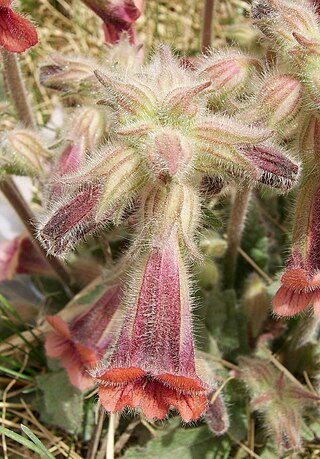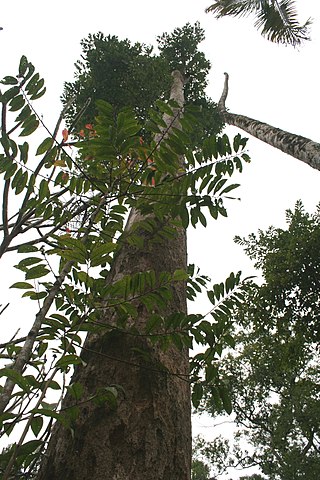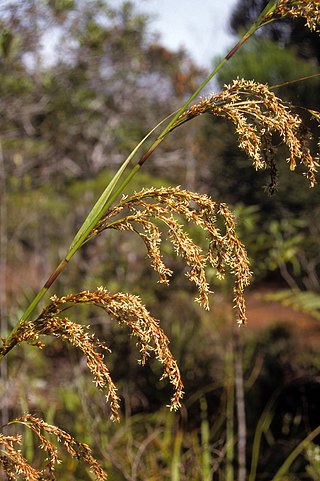
Strobilanthes is a genus of about 350 species of flowering plants in the family Acanthaceae, mostly native to tropical Asia and Madagascar, but with a few species extending north into temperate regions of Asia. Many species are cultivated for their two-lipped, hooded flowers in shades of blue, pink, white and purple. Most are frost-tender and require protection in frost-prone areas. The genus is most famed for its many species which bloom on long cycles of several years, such as Strobilanthes wightii which blooms every thirteen years.

Paulowniaceae are a family of flowering plants within the Lamiales. They are a monophyletic and monogeneric family of trees with currently 7 confirmed species. They were formerly placed within Scrophulariaceae sensu lato, or as a segregate of the Bignoniaceae.

Aeschynanthus is a genus of about 150 species of evergreen subtropical and tropical plants in the family Gesneriaceae. They are usually trailing epiphytes with brightly colored flowers that are pollinated by sunbirds. The genus name comes from a contraction of aischuno and anthos (flower). The common name for some species is lipstick plant, which comes from the appearance of the developing buds emerging from the calyces. A full list of the accepted species and their synonyms can be found in the Smithsonian Institution's World Checklist of Gesneriaceae.

Phrymaceae, also known as the lopseed family, is a small family of flowering plants in the order Lamiales. It has a nearly cosmopolitan distribution, but is concentrated in two centers of diversity, one in Australia, the other in western North America. Members of this family occur in diverse habitats, including deserts, river banks and mountains.

Mitrephora is a genus of flowering plants in the family Annonaceae, that are native to an area that extends from China in the north to Queensland. Plants in the genus Mitrephora are also found in southern India and Southeast Asia.

Rehmannia is a genus of seven species of flowering plants in the order Lamiales and family Orobanchaceae, endemic to China. It has been placed as the only member of the monotypic tribe Rehmannieae, but molecular phylogenetic studies suggest that it forms a clade with Triaenophora. Contrary to the immense majority of the taxa of Orobanchaceae, Rehmannia is not parasitic.

Brassaiopsis is a genus of shrubs in the family Araliaceae. There are about 45 species, distributed in Asia from the Himalaya through China, Vietnam, Thailand to Indonesia.

Leea is a genus of plants in the family Vitaceae, subfamily Leeoideae, that are native to parts of central Africa, tropical Asia, Australia and Melanesia. It was previously placed in its own family, Leeaceae, based on morphological differences between it and other Vitaceae genera. These differences include ovule number per locule, carpel number, and the absence or presence of a staminoidal tube and floral disc. Pollen structure has also been examined for taxonomic demarcation, though studies have concluded that the pollen of Leeaceae and Vitaceae suggests the families should remain separate while other studies conclude that Leea should be included in Vitaceae.

Canthium is a genus of flowering plants in the family Rubiaceae. They are shrubs and small trees. The leaves are deciduous and the stems are usually thorny.

Gymnostachyum is a genus of flowering plants in the family Acanthaceae. It includes 50 species native to tropical Asia, ranging from the Indian subcontinent through Indochina to southern China, Peninsular Malaysia, Sumatra, Java, and the Philippines.

Lasianthus is a genus of flowering plants in the family Rubiaceae. They are tropical subshrubs, shrubs, or rarely, small trees. They inhabit the understory of primary forests.

Madhuca is a genus of plants in the family Sapotaceae first described as a genus in 1791.
Mapania is a genus of plants in the family Cyperaceae. It contains 100 species, distributed in tropical regions of Africa, India, southern China, Southeast Asia, New Guinea, Australia, Central America, northern South America, and various oceanic islands.

Adina is a genus of 12 species of flowering plants in the family Rubiaceae. They are shrubs or small trees, native to East Asia and Southeast Asia.
Wightia is a genus of flowering plants tentatively sister to the Phrymaceae which currently contains only two species. It grows as a tree, or a hemiepiphytic pseudo-vine, up to 15 metres (49 ft) tall. It is found in South Asia and South East Asia, from Nepal and India to Thailand, Vietnam and China's Yunnan Province, at altitudes below 2,500 m (8,200 ft). There are still morphological characters as well as nuclear genome data to support Wightia as sister to Paulownia leading it to be of proposed hybrid origin from Phrymaceae and Paulowniaceae. Due to chloroplast and mitochondrial data showing Wightia as sister to Phrymaceae it is proposed that a new family Wightiaceae be recognized.

Sonerila is a genus of plants in the family Melastomataceae. This genus is characterized the by presence of three petals as opposed to five in the other members of the family. Most members of the genus prefer growing in shady habitats. It is a large genus including about 175 species.

Costularia is a plant genus in the family Cyperaceae. It includes 15 species native to southeastern Africa, ranging from South Africa through Eswatini, Mozambique, Zimbabwe, and Malawi, and to the islands Madagascar, Réunion, and the Seychelles in the Western Indian Ocean.
Boeica is a genus of flowering plants belonging to the family Gesneriaceae. Its native range is Tropical Asia, ranging from the eastern Himalayas to Indochina, southern China, and Peninsular Malaysia.

Leucosyke is a genus of flowering plants belonging to the family Urticaceae.

Ornithoboea is a genus of flowering plants belonging to the family Gesneriaceae. It includes 17 species native to south-central China, Indochina, and Peninsular Malaysia.

















